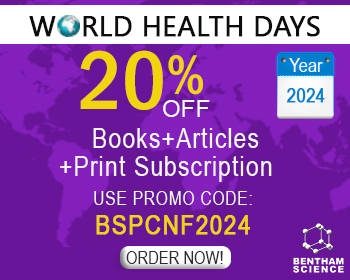Abstract
Endothelial dysfunction is a hallmark of type 2 diabetes that can have severe consequences on vascular function, including hypertension and changes in blood flow, as well as exercise performance. Because endothelium is also the barrier for insulin movement into tissues, it acts as a gatekeeper for transport and glucose uptake. For this reason, endothelial dysfunction is a tempting area for pharmacological and/or exercise intervention with insulin-based therapies. In this review, we describe the current state of drugs that can be used to treat endothelial dysfunction in type 2 diabetes and diabetes-related diseases (e.g., obesity) at the molecular levels, and also discuss their role in exercise.
Keywords: Endothelial dysfunction, exercise, vascular function, insulin, hypertension, pharmacological.
[http://dx.doi.org/10.2174/092986709787002853] [PMID: 19149564]
[http://dx.doi.org/10.1172/JCI200314172] [PMID: 12697739]
[http://dx.doi.org/10.2337/dc10-2421]
[http://dx.doi.org/10.2337/dc11-2399] [PMID: 22961574]
[http://dx.doi.org/10.1210/jc.2009-0027] [PMID: 19567533]
[http://dx.doi.org/10.1152/ajpendo.00497.2005] [PMID: 16682488]
[http://dx.doi.org/10.1155/2019/4912174] [PMID: 31976336]
[http://dx.doi.org/10.14814/phy2.14239] [PMID: 31552710]
[PMID: 15640720]
[http://dx.doi.org/10.1210/jc.2015-3293] [PMID: 26756115]
[PMID: 8997227]
[PMID: 8572189]
[http://dx.doi.org/10.1172/JCI116542] [PMID: 8325979]
[http://dx.doi.org/10.1161/01.CIR.92.10.2911] [PMID: 7586259]
[http://dx.doi.org/10.1172/JCI117433] [PMID: 8083357]
[http://dx.doi.org/10.2337/diabetes.53.6.1418] [PMID: 15161743]
[http://dx.doi.org/10.1113/jphysiol.2010.194035] [PMID: 20643772]
[http://dx.doi.org/10.1007/s00125-004-1525-1] [PMID: 15490108]
[http://dx.doi.org/10.1161/CIRCRESAHA.108.187567] [PMID: 19131647]
[http://dx.doi.org/10.1152/ajpregu.00004.2010] [PMID: 20200137]
[http://dx.doi.org/10.2337/diabetes.53.8.2067] [PMID: 15277387]
[http://dx.doi.org/10.1161/01.CIR.96.1.25] [PMID: 9236411]
[http://dx.doi.org/10.1007/s11892-014-0493-1] [PMID: 24743942]
[http://dx.doi.org/10.1016/j.cmet.2010.03.013] [PMID: 20444418]
[http://dx.doi.org/10.1172/JCI5971] [PMID: 10449437]
[http://dx.doi.org/10.1161/01.CIR.101.13.1539] [PMID: 10747347]
[http://dx.doi.org/10.1038/21224] [PMID: 10376603]
[http://dx.doi.org/10.1161/01.CIR.100.8.820] [PMID: 10458717]
[http://dx.doi.org/10.1172/JCI110852] [PMID: 6339562]
[http://dx.doi.org/10.2337/diabetes.50.11.2611] [PMID: 11679442]
[http://dx.doi.org/10.1016/j.pcad.2017.09.001] [PMID: 28958751]
[http://dx.doi.org/10.2337/dc11-1450] [PMID: 22011409]
[http://dx.doi.org/10.2337/dc07-0183] [PMID: 17626892]
[http://dx.doi.org/10.2337/diacare.25.10.1795] [PMID: 12351480]
[http://dx.doi.org/10.1152/physrev.00014.2016] [PMID: 28151424]
[http://dx.doi.org/10.1002/dmrr.249] [PMID: 11921433]
[http://dx.doi.org/10.1152/ajpheart.00718.2003] [PMID: 14551045]
[http://dx.doi.org/10.2337/diacare.28.12.2877] [PMID: 16306548]
[http://dx.doi.org/10.1016/S1056-8727(01)00197-0] [PMID: 11872366]
[http://dx.doi.org/10.1172/JCI119636] [PMID: 9276741]
[http://dx.doi.org/10.1161/01.CIR.100.11.1223] [PMID: 10484544]
[http://dx.doi.org/10.2337/diacare.26.11.3148] [PMID: 14578253]
[http://dx.doi.org/10.1097/HJR.0b013e3283002733] [PMID: 18677174]
[http://dx.doi.org/10.2337/dc07-0341] [PMID: 17586747]
[http://dx.doi.org/10.5551/jat.3798] [PMID: 20467191]
[http://dx.doi.org/10.1016/j.diabres.2007.09.020] [PMID: 18006170]
[http://dx.doi.org/10.1016/j.fertnstert.2010.06.058] [PMID: 20684955]
[http://dx.doi.org/10.3390/ijms18061321] [PMID: 28635626]
[http://dx.doi.org/10.1249/MSS.0b013e318228bf85] [PMID: 21685815]
[http://dx.doi.org/10.2337/diabetes.53.4.1052] [PMID: 15047621]
[http://dx.doi.org/10.1007/s00125-005-1672-z] [PMID: 15729575]
[http://dx.doi.org/10.1172/JCI13505] [PMID: 11602624]
[http://dx.doi.org/10.1016/j.bcp.2015.10.008] [PMID: 26467186]
[http://dx.doi.org/10.3892/ol.2015.2883] [PMID: 25663871]
[http://dx.doi.org/10.1056/NEJMoa012512] [PMID: 11832527]
[http://dx.doi.org/10.1007/s00125-005-0097-z] [PMID: 16391903]
[http://dx.doi.org/10.2337/dc11-0925] [PMID: 22040838]
[PMID: 30548390]
[http://dx.doi.org/10.1111/acel.13039] [PMID: 31557380]
[http://dx.doi.org/10.2337/dc10-2207] [PMID: 21602430]
[http://dx.doi.org/10.1249/JES.0000000000000070] [PMID: 26583801]
[http://dx.doi.org/10.1161/CIRCULATIONAHA.110.014506] [PMID: 21747057]
[http://dx.doi.org/10.2337/db16-0915] [PMID: 27737949]
[http://dx.doi.org/10.1152/ajpendo.00237.2004] [PMID: 15353407]
[http://dx.doi.org/10.2337/diabetes.50.7.1588] [PMID: 11423480]
[http://dx.doi.org/10.1517/14728210802584126] [PMID: 19046129]
[http://dx.doi.org/10.2337/dc10-1949] [PMID: 21273492]
[http://dx.doi.org/10.1038/aps.2011.149] [PMID: 22120969]
[http://dx.doi.org/10.2337/diabetes.50.3.609] [PMID: 11246881]
[http://dx.doi.org/10.1210/jc.2009-2082] [PMID: 20150577]
[http://dx.doi.org/10.1152/japplphysiol.00680.2018] [PMID: 30307821]
[http://dx.doi.org/10.1016/j.peptides.2013.07.008] [PMID: 23872069]
[http://dx.doi.org/10.1113/EP087449] [PMID: 31020720]
[http://dx.doi.org/10.1093/cvr/cvw182] [PMID: 27450980]
[http://dx.doi.org/10.1186/1475-2840-11-92] [PMID: 22867630]
[http://dx.doi.org/10.14740/jocmr3012w] [PMID: 28611856]
[http://dx.doi.org/10.1111/dom.12706] [PMID: 27300579]
[http://dx.doi.org/10.1111/jcmm.13975] [PMID: 30444033]
[http://dx.doi.org/10.1161/CIRCRESAHA.119.315531] [PMID: 31801409]
[http://dx.doi.org/10.1161/CIRCULATIONAHA.119.043385]



























